MARIANI’S
August
8,
2010
NEWSLETTER

TWA Constellation Ad,
circa 1953
~~~~~~~~~~~~~~~~~~~~~~~~~~~~~~~~~~~~~~~~~~~~~~~~~~~~~~~~~~~
➔ QUESTIONS? TO REACH JOHN MARIANI
WRITE
TO: newsletter@johnmariani.com.
➔ ARCHIVE: Readers
may now access
an
Archive of all past newsletters--each annotated--dating back to July,
2003, by simply clicking on www.johnmariani.com/archive
➔ SUBSCRIBE AND
UN-SUBSCRIBE: You may subscribe anyone you wish
to this newsletter--free of charge--by
clicking here.
~~~~~~~~~~~~~
☛ In
This Issue
WHEN THE HEAT BREAKS
IN
THE NORTH, HEAD SOUTH FOR THE WINTER
Cabo by Carey Sweet
Rancho La Puerta by Joanna Pruess
3030 Ocean by Edward Brivio
NEW
YORK
CORNER: Whatever Happened to Little
Italy? by Franco Lania
OBITUARY: Jimmy
Brennan of Brennan's in New Orleans Dies by John Mariani
MAN ABOUT TOWN: Norwegian's Biggest Liner Debuts by Christopher Mariani
QUICK BYTES
~~~~~~~~~~~~~
WHEN THE HEAT BREAKS
IN THE NORTH,
WHERE TO HEAD SOUTH FOR THE WINTER
The stretch of searing heat that has made summer so miserable in the
USA will eventually break2, and, human beings being what they are, at
the
first
cool breeze of early autumn will start them thinking about places to go
where it is warmer in the south. Here are three great options.
CABO
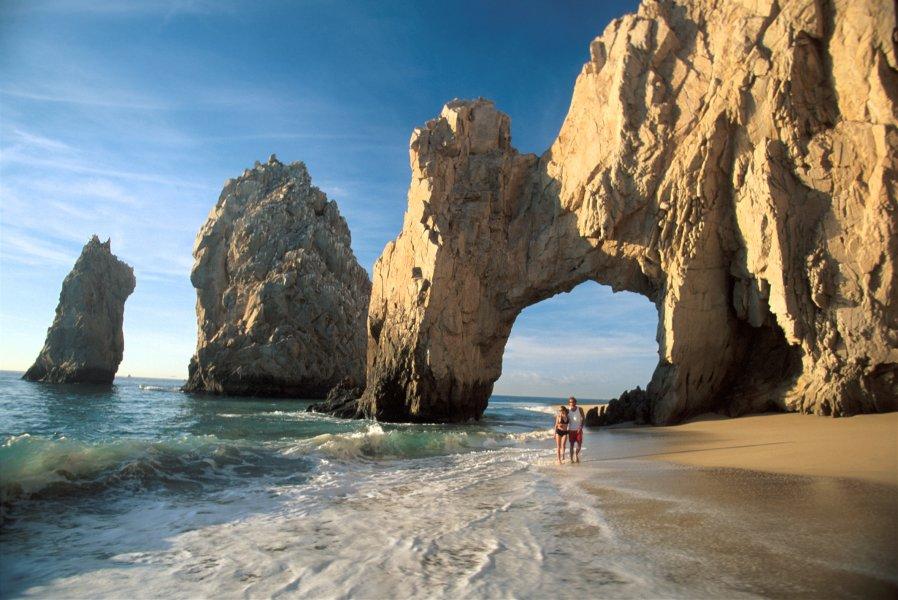
By Carey Sweet
I don’t know which was more
romantic: watching
two of my friends get
married on
the beach, or being kissed by a dolphin.
Both
are
temptations
in
Cabo.
There’s
no
denying
the
fairy-tale
charm
of
saying
“I
do”
in
this
coastal resort city of Mexico
at the
southernmost tip of Baja. As for the dolphin, well, let’s just say that
being
smooched by a 500 pound, rubbery-bodied marine mammal while bobbing
free with
the creature in ocean waters is a Bucket List experience.
Cabo,
it
turns
out,
is
a
favorite
destination
for
weddings.
With
the
right
event
coordinator,
in
fact,
it
can be nearly as easy as making a dinner
reservation.
My friends actually hadn’t even planned on getting married. Yet when
the idea
popped into their heads, we were all tipping back damiana-based
cocktails at
the outdoor bar of the high-end Sheraton
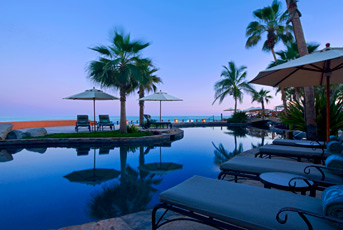 Hacienda
Del
Mar
Golf
&
Spa
Resort’s (left) oceanfront
De Cortez restaurant.
The liqueur comes from a Latin-American shrub that produces intensely
aromatic flowers plus fruits that taste similar
to figs, and, as I later learned, the leaves are supposed
aphrodisiacs: damiana tea
mixed with sugar is said to enhance lovemaking.
Hacienda
Del
Mar
Golf
&
Spa
Resort’s (left) oceanfront
De Cortez restaurant.
The liqueur comes from a Latin-American shrub that produces intensely
aromatic flowers plus fruits that taste similar
to figs, and, as I later learned, the leaves are supposed
aphrodisiacs: damiana tea
mixed with sugar is said to enhance lovemaking.
It
hadn’t
hurt
that
a
whale
had
lazed
its
way
by,
cruising
the
glittering
sapphire waters perhaps a quarter mile
from shore. It was a
sign of good future, our bartender noted, since the whale
season typically runs January through March, when the great beasts
settle in
the Baja peninsula to have their babies,. And now it was April.
My
blind
date
with
a
dolphin
was
even
easier
to
arrange,
requiring
just
an
Internet
reservation.
Cabo
Adventures/Cabo
Dolphins opened in Cabo San Lucas
four years ago, and there are plans to debut a second location in
nearby San
Jose de Cabo sometime next year.
SEA CHANGE
If
Cabo
Tourism
officials
are
promoting
the
romance
of
their
region,
it’s
a
good
message.
Travel
to
Mexico
has
taken its hits over the past few
years, owing
to the swine flu epidemic and worries over drug violence. Yet Mexico
has made
it back to some top 10 travel lists for 2010, while Yahoo's list of
most popular
cities for 2009 based on consumer interest and activity included Cabo
San
Lucas.
Just this month, the State Department's Diplomatic Security Service
recommended
Cabo as one of its best travel choices, calling Baja California Sur one
of the
safest states in the country.
The
last
time
I
had
visited
Cabo
had
been
during
an
engagement.
Alas,
that
romance
didn’t
last,
but my memories of my stay at the
spectacular Westin
Resort
&
Spa
(below) had,
for its j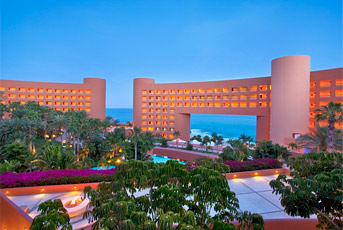 aw-dropping
multi-color
candy
box
architecture
that
salutes
Cabo’s
majestic
Arch,
a
natural
rock
outcrop
that
rises
out
of
the
waves
at Land's End where the Pacific Ocean and the
Sea of
Cortez meets. At the time, there wasn’t much to do in town other than
laze
around the edges of the resort’s infinity edge pool and sip cocktails,
or take
a boat ride to see the Arch’s resident sea lions.
aw-dropping
multi-color
candy
box
architecture
that
salutes
Cabo’s
majestic
Arch,
a
natural
rock
outcrop
that
rises
out
of
the
waves
at Land's End where the Pacific Ocean and the
Sea of
Cortez meets. At the time, there wasn’t much to do in town other than
laze
around the edges of the resort’s infinity edge pool and sip cocktails,
or take
a boat ride to see the Arch’s resident sea lions.
That
was
ten
years
ago.
And
while
the
Westin
is
still
the
most
stunning
property
to
be
found,
the area’s two towns -- Cabo San Lucas, and San
Jose de
Cabo to the northeast near the airport -- have been built up
dramatically. San
Jose de Cabo has Applebee’s, OfficeMax, acres of timeshares, and
massive, boxy
hotels hunkered in a hodgepodge of brands like Crowne Plaza, Best
Western Hotel
& Suites Las Palmas, and Presidente Inter-Continental. It’s clear
what type
of clientele is being wooed: most hotels are all-inclusive.
Driving
into
Cabo
San
Lucas,
our
shuttle
driver
had
pointed
out
the
Costco
has
the
best
views,
and
recommended,
in all seriousness, that we consider it for
lunch
sometime. It seems the patio with its red umbrellas is a preferred
perch for
snacking on a 20-peso hot dog while gazing at the Arch.
I
remembered
a
small,
tourist-y
strip
of
ramshackle
curio
shops
lining
the
Marina
Cabo
San
Lucas,
and
they're
still
there, though suffocated now
by flashy
stores, restaurants and bars such as Johnny Rockets and Ruth’s Chris at
the
Puerto Paraiso mall, or the adjacent Luxury Avenue mall, brimming with
boutiques like Carolina Herrera, Cartier, Hermés, and
Ferragamo.
The
upscale
evolution
made
more
sense
later
when
I
took
a
glass-bottomed
boat
out
to
the
Arch,
and
my
guide pointed to the many mansions looming from
nearby
mountainsides – Sylvester Stallone, Catherine Zeta-Jones and Madonna
all have
retreats here, he said.
SPLASH
ZONE
 One
of
the
best
new
developments
is
Cabo
Dolphins,
right
in
the heart of
downtown
Cabo San Lucas. Visitors enter through a gift shop into what looks like
a
concrete bunker lined with portholes, then out to a sunny courtyard
framed by
an enormous tank. After donning a wetsuit, I braved the cold waters and
slid
into the deep end with a most magnificent mammal.
One
of
the
best
new
developments
is
Cabo
Dolphins,
right
in
the heart of
downtown
Cabo San Lucas. Visitors enter through a gift shop into what looks like
a
concrete bunker lined with portholes, then out to a sunny courtyard
framed by
an enormous tank. After donning a wetsuit, I braved the cold waters and
slid
into the deep end with a most magnificent mammal.
My
bottlenose
friend
was
named
Frieda,
and
even
here,
love
was
in
the
air
–
my
swimming
session
had
to be interrupted when her amorous novio
(that’s Spanish
for boyfriend) kept leaving his customers to come check us out,
circling close
in what the trainer grew concerned was a show of jealousy.
He
eventually
was
put
in
time-out,
though
he
need
not
have
worried:
mine
was
a
whirlwind
romance.
Quite
literally,
as Frieda whipped me on high-speed
turns
around the pool, me clutching her dorsal fin for a furious drag, then
clasping
her pectoral fins for a more leisurely cruise as she flipped upside
down and
made her belly a boogie board.
That
was
pretty
much
the
only
time
I
was
able
to
splash
in
salt
water.
Despite
their
enticing beauty, most of Cabo’s 30 miles of
beaches
prohibit swimming, because the undertow is too strong. Neither the
Hacienda nor
the Westin had warning signs on the silvery sand (most properties do),
but my
Hacienda beach concierge, who can set up cabanas at a
moment’s notice, bring towels and refreshments, and even
customized-to-your-skin type sunscreen s, grinned when I pointed
hopefully towards the sea.
If
I
could
make
it
past
the
thundering,
six-foot
tall
waves
crashing on
shore,
I was welcome to fall off the steep cliffs that led to hammerhead
sharks, he
laughed.
While
Cabo
is
supposed
to
be
among
the
top
five
dive
sites
in
the
world,
its
shipwrecks
and
coral reefs are accessed from just a few coves that are
inconvenient drives from town, and the water, even in the summer, is
teeth-clenching cold. But the dedicated can do it through Cabo
Adventures with
a PADI certified dive team, touring the shallow reef off the North
Wall,
through teams of sea lions at Land’s End Canyon, over Neptune’s Finger
, famous for its sand falls populated by turtles, mantas and angelfish,
or at Pelican’s Rock for
sea horses and tropical fish.
A
HUNGRY
HEART
As
Cabo
has
grown,
its
cuisine
is
working
to
catch
up
to modern tastes.
Coincidentally, on one evening of my vacation, Hacienda’s Pitahayas restaurant
was comfortably overrun with a private party for perhaps 500,
celebrating an
American Academy of Hospitality Sciences Award dinner, where both De
Cortez and
Pitahayas were honored with Five Star Diamond awards.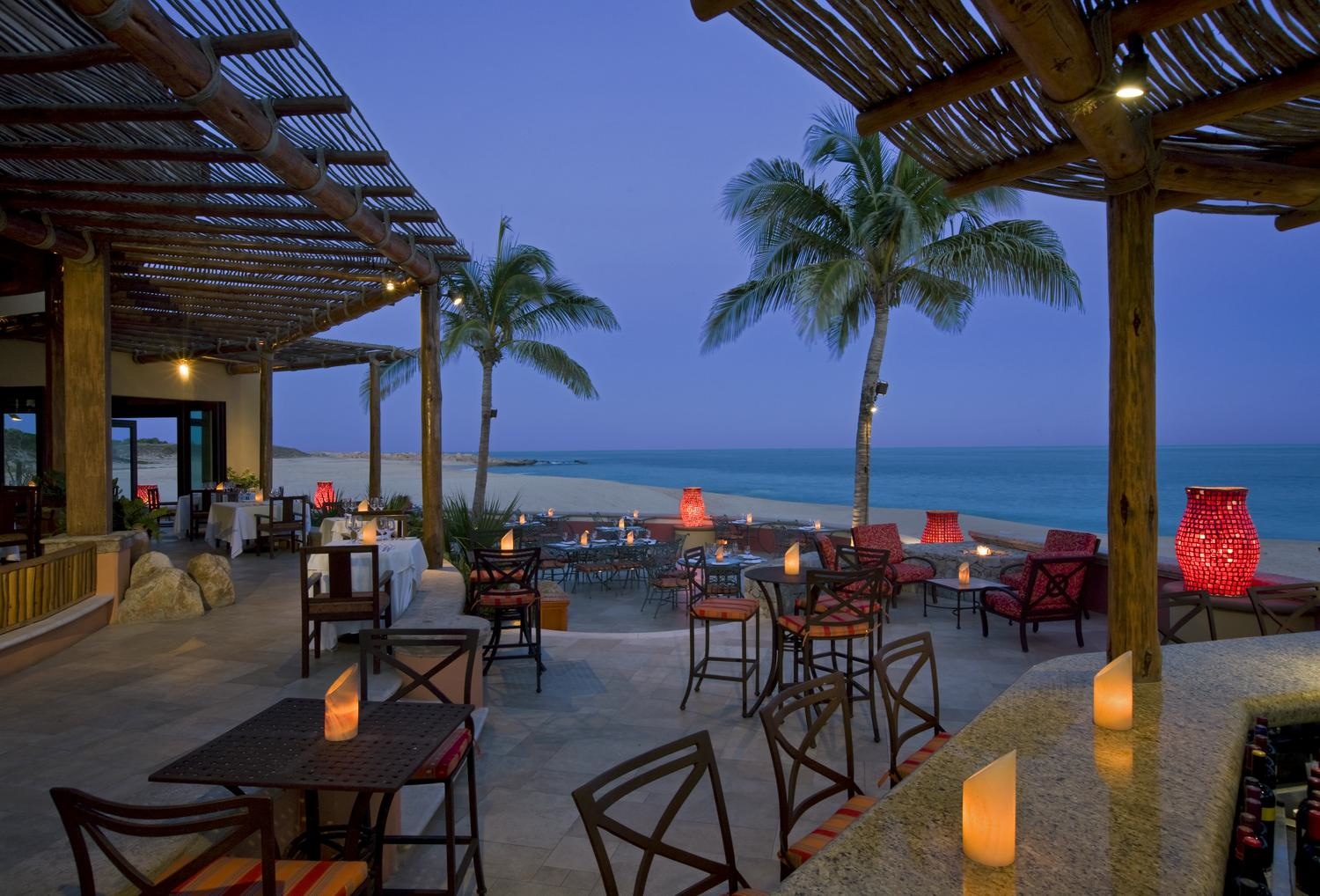
Yet
even
De
Cortez (right), as the resort’s most formal
restaurant, showcases that
always-curious-to-me Mexican adaptation of American and European
dishes.
Indeed, the chef is German and favors international interpretations
like
honey-dipped pineapple stuffed with sautéed Dungeness crab and
served with a
highly briny clam cocktail and tart baby green bean salad; or clove-
and
garlic-rubbed tuna larded with pancetta and spring onions then
pan-fried and
drizzled in bell pepper-chimichurri sauce over buttered wild rice mash.
Then,
there’s
a
Japanese-Mexican
fusion
place
called
Nick-San,
tucked
along the
highway halfway between Cabo San Lucas and San Jose Del Cabo. I was
prepared
for something head scratching, but it’s actually pretty civilized, with
lots of
good fresh fish and a just handful of dishes accented with
Latin-American
ingredients. That means soft shell crab deep-fried and drizzled in soy
sauce
kicked with serrano chiles and chives; or lobster marinated in sake,
soy sauce,
ginger and garlic in a sambal sauce of sweet and sour chiles, green
onion and
sesame oil. Most interesting was a rice cracker tostada of Pacific
yellowfin
tuna belly atop sliced avocado and red onion, kicked up with habanero
and
serrano sauce, then sprinkled in sesame seeds.
One
of
the
best
meals
was
found
back
at
the
Hacienda
in
the
casual
Girasoles
Mexican Restaurant on the property’s highest
level for spectacular
ocean views. A steaming hot molcajete
brimmed with strips of arrachera
steak
and 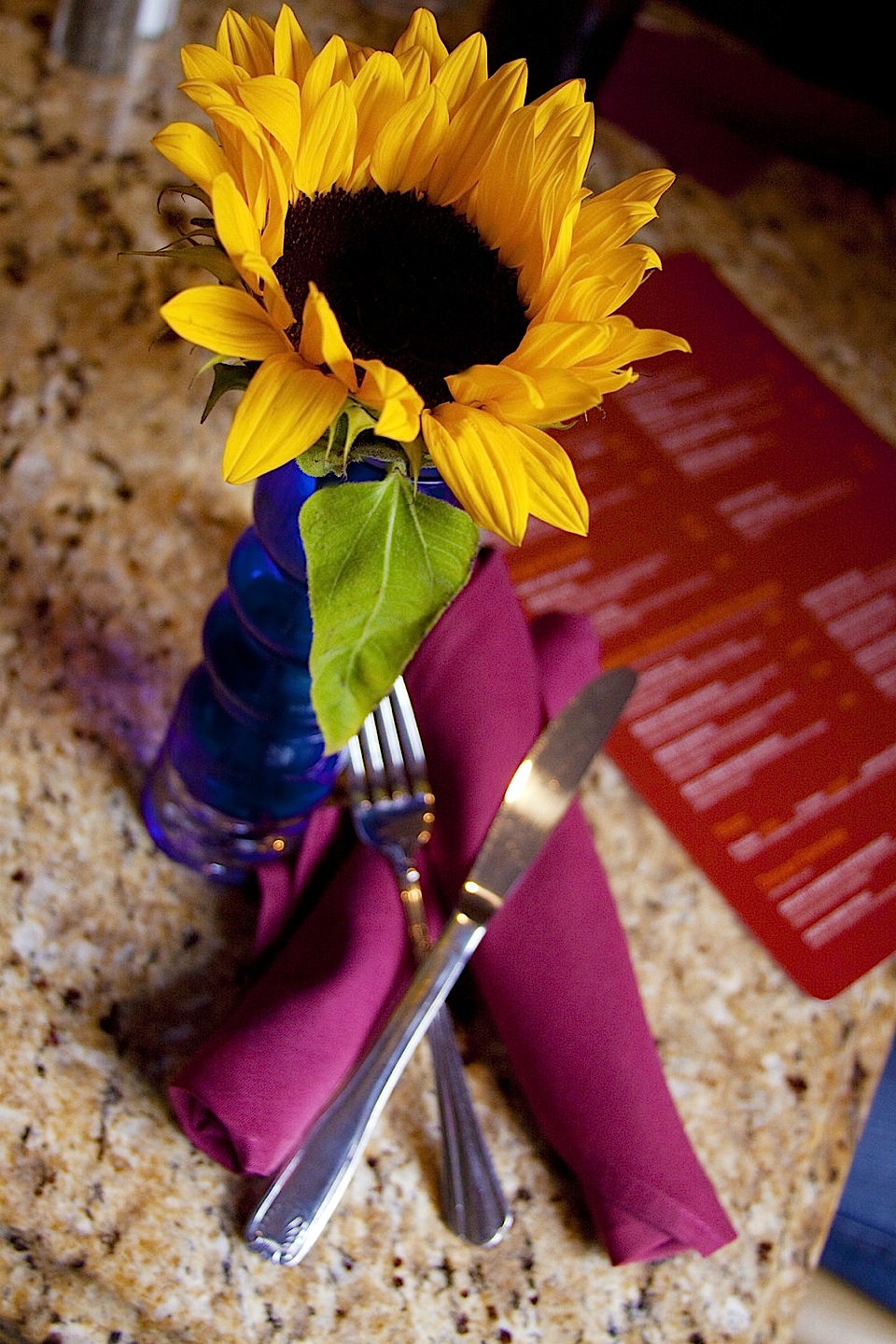 chicken,
chunks
of
fried
panela
cheese,
tiny
whole
charred
onions
still
on
the stem like holiday ornaments, charred whole mild peppers, and
slender rafts
of grilled zucchini stuffed with chorizo. It all sat in a bubbling pool
of
salsa borracha (drunken sauce)
of chiles and beer, to be bundled in lacy thin
corn tortillas and popped in the mouth like savory bonbons.
chicken,
chunks
of
fried
panela
cheese,
tiny
whole
charred
onions
still
on
the stem like holiday ornaments, charred whole mild peppers, and
slender rafts
of grilled zucchini stuffed with chorizo. It all sat in a bubbling pool
of
salsa borracha (drunken sauce)
of chiles and beer, to be bundled in lacy thin
corn tortillas and popped in the mouth like savory bonbons.
For
dessert,
we
ate
way
too
many
churros,
the
skinny
fried
dough
wands
fluffy-light
inside
and
crunchy
on
the edges, dunked in vanilla and
bittersweet
chocolate sauces.
GOT
TO
GET
DOWN
In
the
new
Cabo
San
Lucas,
one
thing
remains
the
same:
there's
always
a
party
going
on,
with
many
restaurants doing double-duty as popular bars and
nightclubs.
Venues
are
predictable
tourist
traps
–
there’s
El
Squid
Roe,
Giggling
Marlin,
and
the
new
Hacienda
El
Coyote.
Cabo
Wabo Cantina is a classic from rock star
Sammy Hagar (Sammy himself was in town, and our straggling 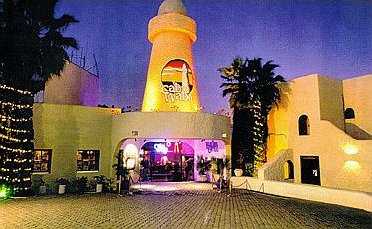 group
just
missed
his
impromptu
show.
A
theme-park
thrill,
yes,
but
it’s
still
a fun place to get a decent Waburrito (chicken breast
sautéed
with garlic, tomatoes, chipotle chile and onions finished with jack
cheese and
cream) or Camarones Sammy of fresh shrimp sautéed with garlic
and serrano then
deglazed with lime juice and Cabo Wabo tequila.
group
just
missed
his
impromptu
show.
A
theme-park
thrill,
yes,
but
it’s
still
a fun place to get a decent Waburrito (chicken breast
sautéed
with garlic, tomatoes, chipotle chile and onions finished with jack
cheese and
cream) or Camarones Sammy of fresh shrimp sautéed with garlic
and serrano then
deglazed with lime juice and Cabo Wabo tequila.
For
a
quieter
time,
historic
San Jose del Cabo is charming, a
mix of old and
new, with more authentic craft boutiques and dignified dining. One of
the best
bets is La Panga restaurant, serving
contemporary Mexican food in a Colonial
setting from chef/co-owner Jacobo Turquie. The seafood-centric menu
shines with
seared sea scallops on a bed of chile-saffron risotto, asparagus tips
and bell
peppers; or ahi lacquered in honey, rosemary and guajillo pepper over
squash
blossoms and corn-studded rice. This
sleepy little town also does a brisk wedding business, with several
small
chapels or churches in traditional Spanish Mission architecture.
Still,
if
Cabo
is
competing
with
other
oceanfront
destinations
around
the
world
for
the
romantic-minded
crowd,
it’s
got
one
distinct option for a whole
other
clientele.
I
couldn’t
decide
which
was
more
amusing:
first
seeing
Lover’s
Beach,
next
to
the
Arch
on
the
calm
Sea
of Cortez, or second, Divorce Beach, mere
steps away
on the other side of the rocks and fronting the thrashing Pacific.
 SPA FOOD – Rancho La Puerta -Style
SPA FOOD – Rancho La Puerta -Style
By Joanna Pruess
When my invitation to a major high school reunion arrived last spring, I was shocked at how fast the decades had flown by. Soon afterward, my London-based daughter called to say she had been hired away from her job at Google. Milestones or turning points like these are often the impetus to jump-starting a fitness routine. For Nicole and me, a “spa-cation” seemed an ideal way to begin the process.
Rancho La Puerta has been making healthy people healthier for 70 years, according to their current brochure. The Ranch, in Tecate, Baja California, is four miles across the border from San Diego. It was co-founded by Deborah Szekely (right) with her late husband Edmond. At eighty-eight, she is still remarkably vibrant and remains at the forefront of the modern health and fitness movement. “This isn’t a boot camp,” Szekely says emphatically. Our emphasis has always been on total health: the mind, body and spirit.
Judging by the large number of repeat guests – several have come more than 30 times – health-focused vacations are a popular lifestyle choice, from teens through seniors. We met a dozen mother-daughter duos plus a couple of three-generation groups who were all actively participating in the programs. While predominantly female, there was a smattering of husbands and single men.
The
facility’s
3,000
acres
include
32
acres
of
gardens,
hiking
trails
of
varying
degrees
of
difficulty,
a
six-acre
organic farm, several
swimming pools,
extensive spa and fitness facilities and beauty salons. Dramatic works
of art
by local talent accent the property. Getting in shape takes
exercise and there are plenty of activities here,
including daily hikes (a 3.5-mile trek up steep Mount Kuchumaa was a
highlight
for me). Additionally, I joined tennis clinics, Pilates, yoga,
Feldenkrais, and
tai chi classes; cardio-circuit training, as well as African and Latin
dancing.
The kinks in my long-neglected muscles were kneaded by expert masseuses
like
Luz Esther. Nicole took full advantage of the Ranch’s HYDRO-FIT aquatic
exercise program.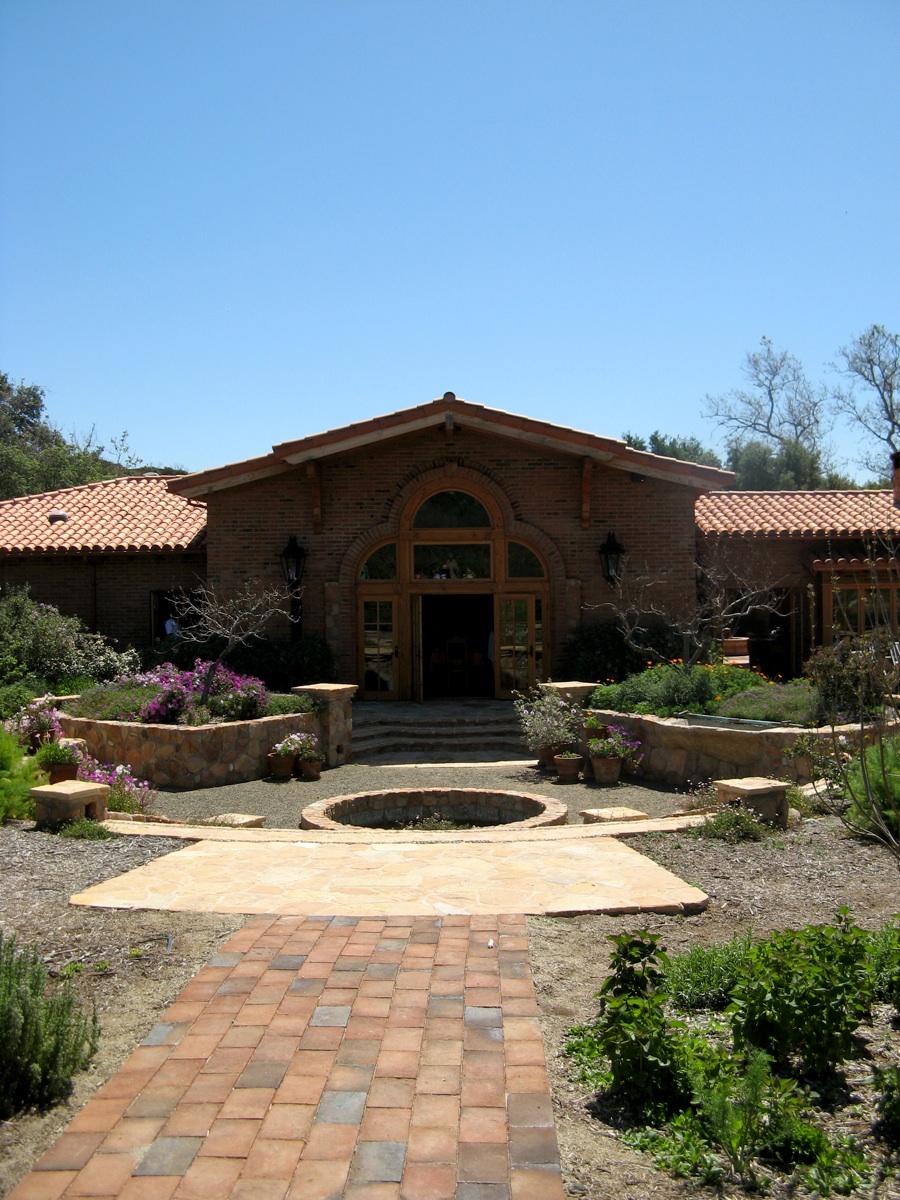
Beyond physical challenges, there are topical lectures – on subjects like keeping your brain healthy as you age and smart eating – and fun activities like jewelry making, movies and Bingo, where fitness director Barry Shingle, keeps everyone in stitches for his slightly risqué performance as leader. It’s like going to an idyllic camp for grown ups.
Food, Really Delicious Food
When
I
returned
home
looking
healthy
and
toned
up,
many
friends
asked
about
the
food.
Was
I
ever hungry or bored? Never.
Even my
daughter, who can be a picky eater, found plenty to appreciate about
the meals
served buffet-style for breakfast and lunch and family-style at
dinner.
More
than
sixty
years
of
research,
culinary
creativity
and
experimentation
have
resulted
in
an
all-natural
diet
that
is
low
in fat, sodium, and refined flour and sugar, while high in energy,
fiber and
complex carbohydrates. Along with being quite tasty, the food is
visually
exciting and varied, traits which go a long way to making healthy fare
enticing. Dishes, like Lasagna Azteca with Spinach and Ancho Chile
Salsa arrive on colorful,
rustic serving
platters.
We figured out pretty quickly that there are few rules about what or how much you can eat, or, to a lesser degree, drink. Wine is available, if you ask, and on several occasions we ordered both main courses and extra side dishes to try. While guidelines are there in the suggested portion sizes, the take-away is about making your own choices. A couple of people snuck in chocolate bars; others went into town to sample the local food and the margaritas, but most people don’t want to escape. Meals are social events and it is fun discovering less familiar ingredients, like agave syrup to sweeten your tea, pasilla chiles, nopales and black quinoa, while feeling that what you are eating is good for you.
Guests who want to duplicate some of the techniques and dishes at the Ranch can attend La Cocina Que Cante, "the kitchen that sings" (below), their on-property cooking school.
Michel Stroot, the chef emeritus of Rancho La Puerta, was a guest instructor. He has been cooking spa food for over 25 years at both Rancho La Puerta and Golden Door,in Ensenada (formerly owned by Szekely). Over the years, the idea of spa food has evolved from strict diets limited to 900 to 1500 or 1800 calories to what it is today. Stroot told me, “I remember people used to say oil makes you fat. Finally, someone intelligent said ‘it’s not the oil, it’s the white flour, saturated fats and processed foods.’” Moderation is important, but so are taste, texture and satiety. After tasting the black quinoa tabbouleh salad with pine nuts, red peppers and red onions we were preparing, he added more olive oil and chuckled, “It needs it.”The recipe is in Cooking with the Seasons at Rancho La Puerta, their James Beard-nominated cookbook written by Deborah Szekely and Deborah M. Schneider, with Jesús González, the school’s former teaching chef.
One
important
reason
why
food
tastes
so
good
at
Rancho
La
Puerta
is
its
proximity
from
the
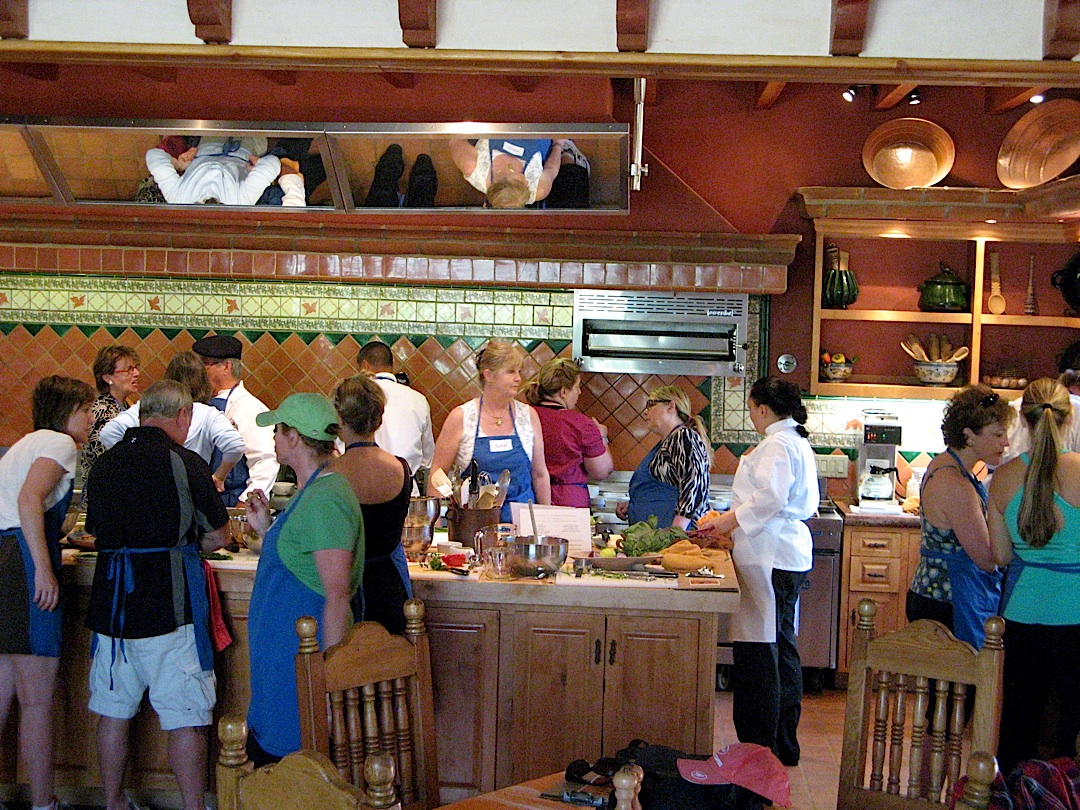 earth
to
the
table.
Students
of
the
cooking
school
see
this
first
hand
when
chief
gardener
Salvador
Tinajero
leads them into the Ranch’s
organic
gardens to harvest the baby vegetables, lettuces and edible flowers
used in
their recipes. The colors, aromas, and tastes are nothing short of
amazing, and
Salvador’s pride and passion are extraordinary.
earth
to
the
table.
Students
of
the
cooking
school
see
this
first
hand
when
chief
gardener
Salvador
Tinajero
leads them into the Ranch’s
organic
gardens to harvest the baby vegetables, lettuces and edible flowers
used in
their recipes. The colors, aromas, and tastes are nothing short of
amazing, and
Salvador’s pride and passion are extraordinary.
Guacamole
(above) is one of
the Ranch’s most popular
dishes. It is served each week along with sangria at the newcomers’
reception.
The well-seasoned and addicting dip is “enlightened” by substituting
puréed
frozen green peas for half of the avocados used, and the pita chips are
baked,
not fried. Like Rancho La Puerta itself, the dip strikes
the
perfect note of healthful living with taste and style and can easily
become a
part of one’s life.
In the end, Nicole and I came away
feeling refreshed and
far healthier than when we arrived. Our commitment is to return every
year
together to keep in touch with our bodies and to see many of the new
friends we
made. This includes Deborah Szekely, who is currently working on a
“living
skills” seminar and hoping to get it in front of Michelle Obama and her
task force for children’s eating. She is a true inspiration and, in a
word, I
aspire to be like her in the decades to come. But first, on to the
reunion.
Joanna
Pruess has written about food and travel for the New
York
Times,
Washington
Post,
Saveur,
Food
Arts
and
Associated
Press.
Her most
recent cookbooks, Cast-Iron
Cooking: Delicious and Simple Comfort Food and Seduced by Bacon:
Recipes and Lore about America’s Favorite Indulgence, are available at
Amazon.com.
FORT
LAUDERDALE
DINING:
3030
OCEAN
by Edward Brivio
Photos by Robert Pirillo

For ten years now, Chef Dean Max has presided over his signature restaurant, 3030 Ocean, located in the Marriott Harbor Beach Resort in Ft. Lauderdale. The dining room is a large, oblong, contemporary space, with its basic post-and-beam construction laid bare. Neutral colors--tans and pale terra cottas--and white linens allow one to appreciate the eloquence of the structural elements: substantial, square posts, sheathed in wood, support lengthy horizontal rafters, creating a long, fluid, uninterrupted space that is light and airy. Down the center a row of large, circular light fixtures hug the ceiling . Cliché-free, pared down, and with color at a minimum, the room still manages to feel warm and inviting rather than austere, the kind of place where you can dress-up or dress-down and feel comfortable either way.
Executive
Chef
Dean
Max’s
recipes
are
brought
to
life
every
night
by
enthusiastic
Chef
de
cuisine,
Jeremy
Ford. Acidity is the key that keeps the dishes here
fresh and irresistible. Sauces are light and bold, whether
vinaigrettes: lemon
verbena, raspberry, piquillo peppers,
or fennel/chili; aiolis: dill, lemon,
sesame/chili, or yuzu; zingy salsas, one
from
peaches,
another
from
green
olives,
or
limpid
jus.
Having
spent
his
life
living
along
the
water
(see
his
first
cookbook,
A Life by the Sea)
as well as a large chunk of his formative years helping out on family
farms and
in the family kitchen has not only made Chef Max a master at
cooking
anything finned or shelled but also given him a n eye for the best,
and
freshest produce. His menu reads like a international
glossary of foodstuffs; his sources span the globe, proudly
acknowledged on the menu; place-names abound: delicate
Bouchot mussels from
Green’s Island, Maine, served in a spicy, ginger and lemongrass
stock,
while tiny, local, quarter-sized, white water clams in a basil and
leeks broth
were knocked up a rung on the taste ladder by the addition of a
tiny-dice of
spicy, crisp, and meaty Spanish chorizo. Or begin
with a vibrantly fresh plâteau de fruits de mer,
or a
smoked
grouper fish dip that put the usual brandade de morue to shame.
Peaches
from
Jansal
Valley (a major distributor of high-end produce) are
used in a
delicious
sweet-sour salsa that complements superb foie gras (below), about
as
smooth
and
silky
as
it
gets. Tangerines revamped a shaved asparagus
salad, upon
a mound of which sat a blue-cornmeal coated soft-shell crab (below, right), hands-down
ecample it has ever been my
pleasure to
eat. Lemon aïoli made for the ideal
dipping sauce. Perfectly poached Dover sole came served atop a
parsley and olive potato salad, an unexpected but delicious
combination. Even
the beet puree alongside was a thing of exquisite beauty, with an
intense flavor. and color. Another night, local wahoo, seared
rare
and
served with wild greens and Swank Farm turnips from a hydroponic farm
in Loxahatchee,
Florida, and blue nose bass, line-caught in New Zealand, paired with
more of
that olive/potato salad and beet puree, were the evening’s specials.
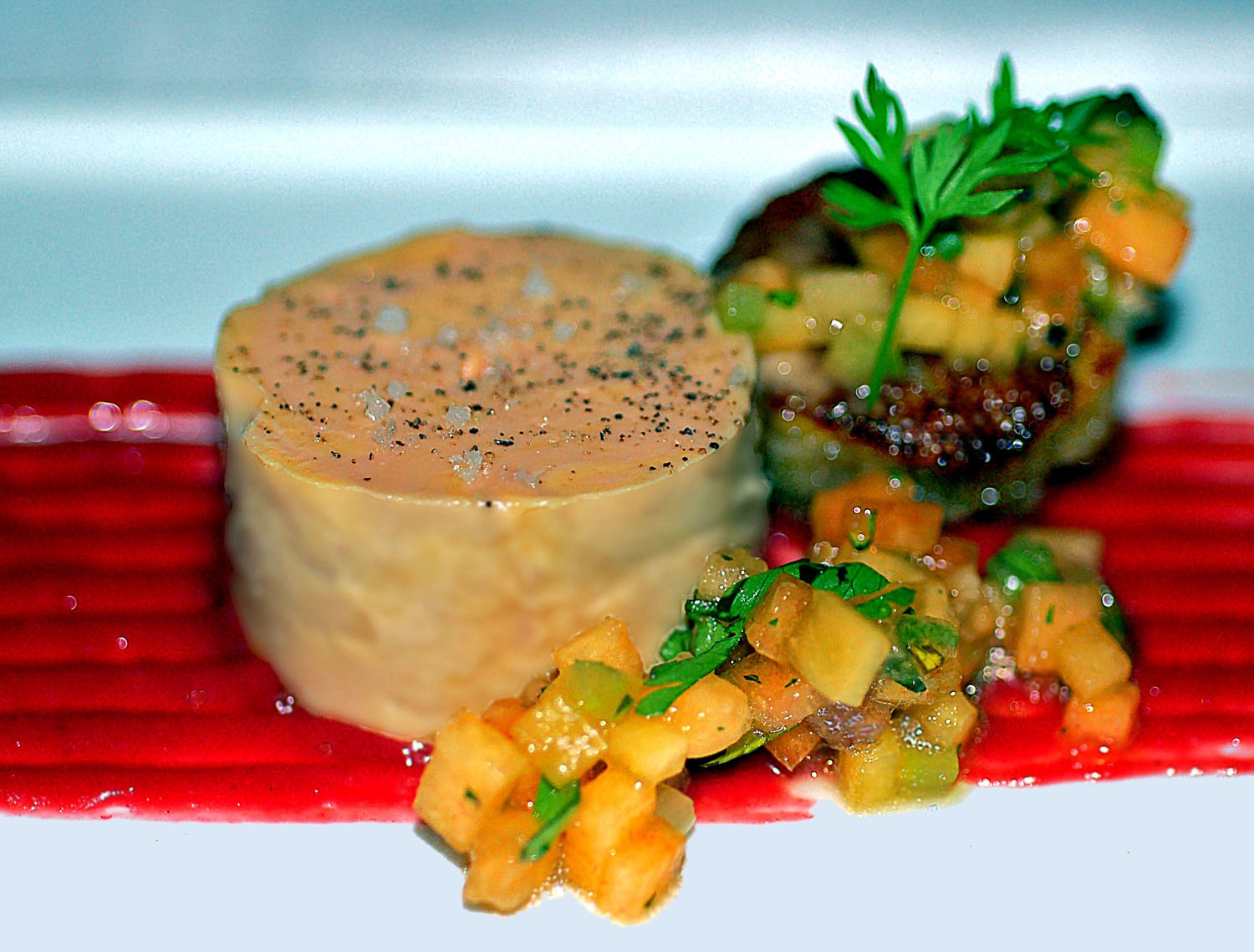 For
steak
lovers,
chef
Ford
grills
a
Kansas
City
Strip,
and
a
beef
tenderloin,
the
first
with
more
Swank Farm turnips, a
morel jus and topped with a diminutive fried
quail’s egg, the second with an heirloom beet carpaccio from
chef
Dean’s
own
farm,
wild
mustard
greens,
a
cabernet
sauvignon-based
sauce,
and
another
quail
egg,
this
time
poached.
For
steak
lovers,
chef
Ford
grills
a
Kansas
City
Strip,
and
a
beef
tenderloin,
the
first
with
more
Swank Farm turnips, a
morel jus and topped with a diminutive fried
quail’s egg, the second with an heirloom beet carpaccio from
chef
Dean’s
own
farm,
wild
mustard
greens,
a
cabernet
sauvignon-based
sauce,
and
another
quail
egg,
this
time
poached.
The
cheese
course
consisted
of
three
excellent
choices:
a
tartufo, from Italy, with
cherry chutney; bosina, with plum
chutney (a variant of robiolla) from
the small Italian town of Bosina) that was new to me; and finally
a manchego, the
wonderful
hard-rind Spanish cheese, with salty
caramel.
Milk
chocolate
panna cotta, so
tender you wondered how
it remained a solid, lime meringue tart with a kiwi and basil syrup, a
black
berry cabernet sorbet that was a dense, dark, deep purple thing of
beauty, and,
for a whimsical touch of pure Americana, a root beer float
made with
small-batch root beer.
Only
the mango tarte tatin was disappointing,
just a little dull, especially in this company.
Restaurant
manager
and
Sommelier
Nicole
Jackson's
wine
vocabulary
is
immense,
spans
the globe,
and packed with the unexpected. To begin, an excellent bubbly,
Schramsberg‘s,
Mirabelle, Brut Rosé, beautiful in the glass and wonderful on
the
palate. Then
a crisp, tasty, classic Sancerre from the Château  de Sancerre, and a Bellingham
Chenin Blanc from Cape Town, South Africa, a full-bodied (14.5%
alcohol),
mouth-filling white with concentrated, ripe fruit flavors of peaches
and
melons, something almost creamy in the texture, and lemony acidity, in
a
framework of spicy oak.
de Sancerre, and a Bellingham
Chenin Blanc from Cape Town, South Africa, a full-bodied (14.5%
alcohol),
mouth-filling white with concentrated, ripe fruit flavors of peaches
and
melons, something almost creamy in the texture, and lemony acidity, in
a
framework of spicy oak.
A
big, earthy Chassagne-Montrachet, from
Janotsbos in Meursault, made a fitting finale to the whites, with
lovely green
apples, a hint of the lees, and clean minerality. The reds debuted with
a wonderful, truly
Burgundian-style Pinot noir, from Four Graces in the Willamette Valley,
Oregon.
Then a wine called Dead Letter Office,
from Henry’s Drive, a textbook Australian Shiraz with big,
luscious blackberry fruit, but nicely balanced with unexpected acidity.
Pinotage (from Fairview in South Africa) is not one of my favorite
reds.
There’s something of the strumpet in its upfront, brazen charms, and
too
obvious desire to please, and too great a whiff of the manufactured in
this
amalgam of Pinot Noir and Cinsault, two cèpages
that given their druthers--as well as their provenance--would
(should) never
have anything to do with each other. And finally, a full-bodied,
smoky Old Ghosts, Old Vines Zinfandel from the Klinker
Brick Winery in Lodi, California with 15+% alcohol, and big,
almost jammy fruit
that never became hot, heavy or cloying.
3030 is open daily.
Starters: $13 to $16, Entrees: $27 to $54; 3-course,
Chef’s
Selection
menu
$48;
$59
with
wine.
~~~~~~~~~~~~~~~~~~~~~~~~~~~~
OBITUARY: Jimmy Brennan of Brennan's in New
Orleans Dies
by John Mariani
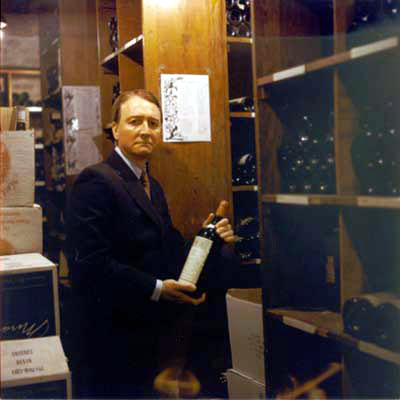 On
the
night
after
Hurricane
Katrina
ripped through New Orleans and closed
down Brennan's restaurant on Royal Street,
Jimmy Brennan and his chef Lazone Randolph sat up
with pistols loaded to ward off any looters intent on robbing their
30,000
bottle wine cellar of its treasures. “They’d probably be more
interested in the
booze,” said Brennan, "but we weren’t taking any chances. We had a magnum of 1857 Lafite-Rothschild in
there!”
On
the
night
after
Hurricane
Katrina
ripped through New Orleans and closed
down Brennan's restaurant on Royal Street,
Jimmy Brennan and his chef Lazone Randolph sat up
with pistols loaded to ward off any looters intent on robbing their
30,000
bottle wine cellar of its treasures. “They’d probably be more
interested in the
booze,” said Brennan, "but we weren’t taking any chances. We had a magnum of 1857 Lafite-Rothschild in
there!”
Weeks later, when Jimmy
It wasn't losing the wines that
killed Jimmy, 70, it was a long bout of cancer, but knowing the
red-headed Irish-Americans' passion for good wine--and the good life
itself--I could only imagine how he'd felt in those dark, post-Katrina
days. Nevertheless, Jimmy and his family, including his brothers
Pip and Ted, re-opened Brennan's, and Jimmy re-built the
wine cellar into one of the city's finest.
The story of Brennan's, opened by
their father Owen in 1946, has been told many times, including in a Brennan's
cookbook, along with the story of how Jimmy's branch of the family
parted ways with Ella Brennan's side so that the former retained
Brennan's and the latter opened Commander's Palace and other
restaurants. Until recent years Jimmy, Ted, and Pip were at their
restaurant either in full force or one at a time, while younger
members of the family have taken over much of the current management,
which means there has never been a tic in the consistency of Brennan's
food or renowned hospitality--the great dishes like turtle soup,
grillades and grits, and their signature bananas Foster--and Jimmy's
wine cellar was a big part of the restaurant's allure.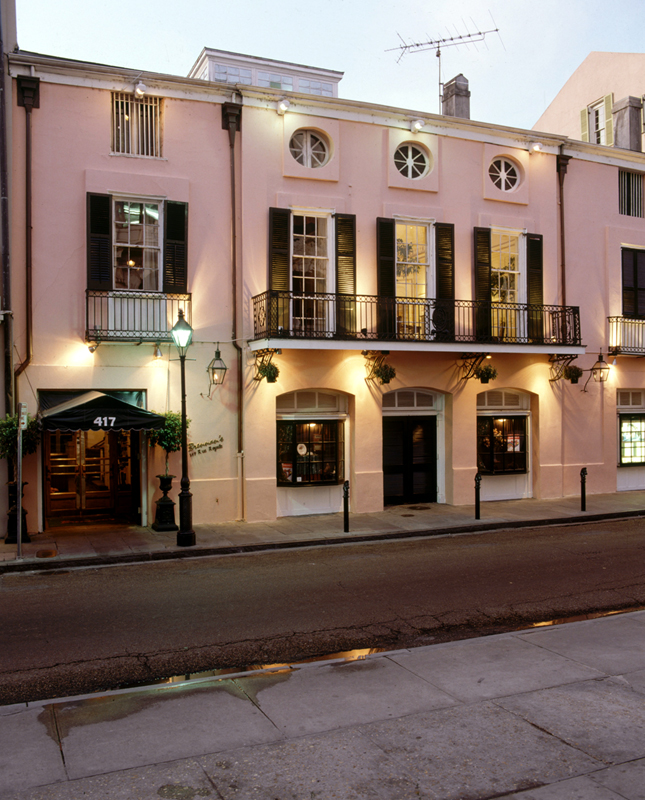
I knew Jimmy pretty well, saw him
every year or so, had a few cocktails with him and way too much fine
wine. He once bet me any bottle in his cellar that the casino then
being built in New Orleans would be a big success within two years,
which I thought was ridiculous. I forget who won the bet, but two
years later he broke out some spectacular Burgundies over dinner
anyway.
He could talk wine till the church
bells rang, his eyes widening as he described in detail a rare bottle
he'd
enjoyed twenty years ago or the prospect of receiving a case of First
Growth Bordeaux the following week. His was a connoisseurship
built solidly on drinking, not tasting, wine, and he was never one to
store the stuff away as trophies to be admired. He'd traveled
widely, knew everybody in New Orleans and, it seemed, half of
Europe. If he could be distinguished from his brothers, I guess
you'd say he was definitely not
the quiet one, for his ebullience showed in his bouncing eyebrows and
his handwaving, the very definition of joie de vivre. Yet he had
a wonderfully dry wit, as when he would describe a chef he greatly
admired by saying, "The man knows how to cook."
If anyone embodied the swagger of
New Orleans, it was Jimmy Brennan, and I'll miss him terribly. No one I
ever met knew better how to "let the good times roll."
NEW
YORK
CORNER
Whatever
Happened
to
Little
Italy? by Franco Lania
Little
Italy was once a vibrant neighborhood where good food and charming
restaurants were abundant. Now, except for a few old timers like
Di Paolo's Fine Foods and Alleva Dairy, Ferrara's Pastry, and remnants
of days when tourists and New Yorkers flocked here for a true sense of
history, there is little left that is not more hype than substance.
Guest writer chef-restaurateur Franco
Lania tries to explain what happened.--John Mariani
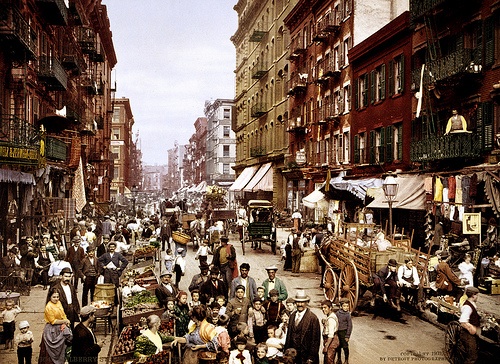 Many
people
have
asked
me
what
do I
think happened to poor Little Italy? Why has it deteriorated so much?
Since I
live only blocks away from the neighborhood, and once worked as a chef
in
Little Italy, what do I feel caused the deterioration of that once
great
neighborhood?
Many
people
have
asked
me
what
do I
think happened to poor Little Italy? Why has it deteriorated so much?
Since I
live only blocks away from the neighborhood, and once worked as a chef
in
Little Italy, what do I feel caused the deterioration of that once
great
neighborhood?
Having
family myself that came from
Italy to the United States via Little Italy back in the first half of
the 1920’s, I can say that upward mobile flight by the children
of the immigrants began
the demise of the neighborhood. I grew up hearing stories from time to
time about
how beautiful Little Italy was, what a fun place it was, how the food
and
feasts were always something to look forward to!
This is a
far cry from today’s
Little Italy. The feast of San Gennaro is pretty much the only street
fair left in
Little Italy and is always in controversy with the city over if it
could
continue or not. The food in Little Italy has a poor reputation and the
foodie
people of NYC typically avoid the area because of this poor food
reputation and
tourist crowds.
The Italian
specialty shops are
pretty much nonexistent and the few that are left are not enough to
help uplift
the neighborhood. The best. most reliable draws for good food in Little
Italy are Angelo’s
(opened in 1902) and Il
Cortile, two restaurants that are  still
excellent but frequented pretty much
by the bridge-and-tunnel crowds from outside of the city. The tourists
usually
meander up Mulberry Street looking for a quick bite and a cheap deal,
as they
make their way to their real places of interest, Soho and NoLita.
Catering to
the tourist crowed instead of the New Yorkers is one of the main
downfalls of
Little Italy.
still
excellent but frequented pretty much
by the bridge-and-tunnel crowds from outside of the city. The tourists
usually
meander up Mulberry Street looking for a quick bite and a cheap deal,
as they
make their way to their real places of interest, Soho and NoLita.
Catering to
the tourist crowed instead of the New Yorkers is one of the main
downfalls of
Little Italy.
In a
nutshell this is what happened.
Little Italy
was a neighborhood based on immigrants who came from Italy starting in
the late
1800s and early 1900s. These early Italians had a safe haven in a city
and
country they knew nothing, and few could speak, read or write English.
Most of
the first wave of immigrants never really assimilated into the city or
America for
that matter and in not doing so kept Little Italy very much alive
and thriving
for years. The comfort of being
able to communicate in their own language and to stay close and near to
the people
and customs they could relate to was a huge factor in their not leaving
the
neighborhood.
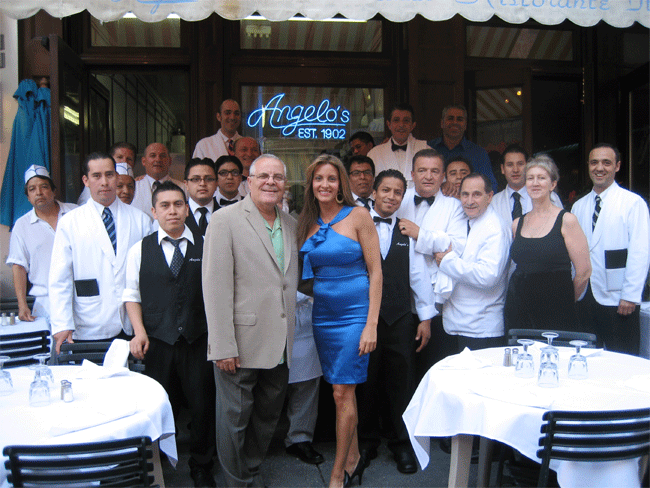 Time moved on
and eventually the first-
and second-generation children of these immigrants become educated and
assimilated into NYC, and become Americanized, wanting more than Little
Italy
has to offer them. These now Italian-Americans
left the neighborhood in search
of their fame and fortune outside the old neighborhood and entered into
the
American Dream. Eventually over time the only ones left are the old
timers and
the few families that never left.
Time moved on
and eventually the first-
and second-generation children of these immigrants become educated and
assimilated into NYC, and become Americanized, wanting more than Little
Italy
has to offer them. These now Italian-Americans
left the neighborhood in search
of their fame and fortune outside the old neighborhood and entered into
the
American Dream. Eventually over time the only ones left are the old
timers and
the few families that never left.
The
ones
left
behind
can’t
maintain
and keep the vibrancy of the neighborhood alive, so it changes
and
goes on its ever downward spiral. The people who left the
neighborhood and made
successes of their lives far beyond the dreams of their parents or
grandparents
never seem to get involved in the now old neighborhood and show an
interest in
the preservation or gentrification of it.
Italian-Americans
must unite to change what has happened to New York’s-Little Italy. It’s
not to
late. With unification and determination Little Italy could be
uplifted and
given an “Italian Cultural Renaissance”
that it so deserves! It needs empowerment by the City of New York, or
else New Yorkers and
Italian Americans alike won’t have a Little Italy to even write
about! At this point Little
Italy is like a mother that gives and gives and never receives anything
back in
return from her children. Eventually she becomes old, run down and
tired.
~~~~~~~~~~~~~~~~~~~~~~~~~~~~~~~~~~~~~~~~~~~~~~~~~~~~~~~~~~

MAN ABOUT TOWN
by
Christopher Mariani
Norwegian
Cruise Line Launches
Its Largest Ship Yet
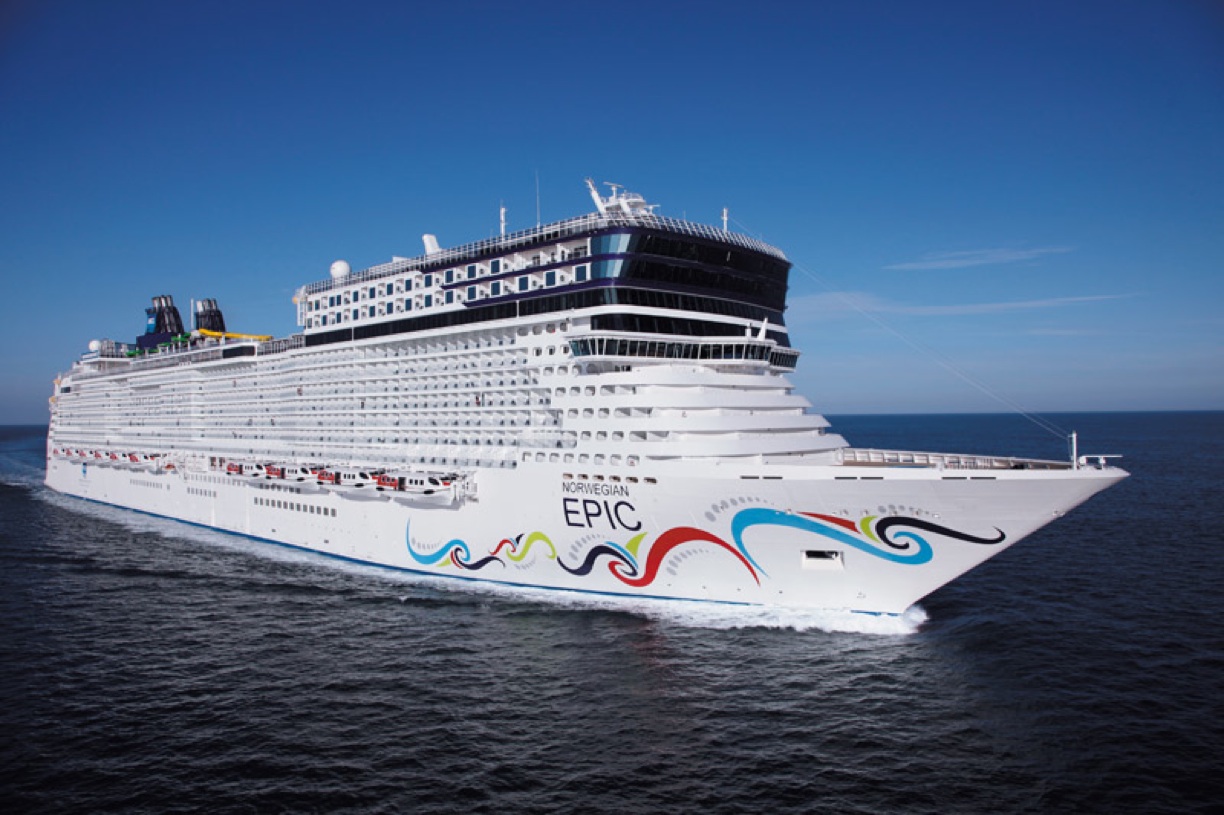 Is
bigger
better
when
it
comes
to
boats?
Is
bigger
better
when
it
comes
to
boats?
This
past July 4th
weekend, I spent two days onboard the massive 4,100 passenger Norwegian
Epic's for its press preview cruise. As I approached Pier 88 off NYC’s Westside
highway, my eyes widened in amazement as the Epic
came into
view and I immediately understood
why this ship is the largest ever to dock in the Hudson River. Standing 19 decks
tall, the ship was mammoth, towering
over
the
city’s
pier
like
a
wide
skyscraper a thousand
feet in
length, its exterior
decorated with blue, red, and green flares that began at the ship’s bow
and
trailed along the side where they eventually met up with the ship’s red
and
white life boat.
Once onboard, I did not get the feeling I was really on a ship; it was more like being inside a royal city like Oz. Its design is centered around a gigantic contemporary chandelier that hangs through the main decks and offers passengers a sense of direction and location while touring its beautiful interior. I spent my first hour wandering around the ship and was happy to find how easy it was to navigate unlike the mazelike lay-out as so many liners.
I stayed in a balcony
stateroom
(right) that was quite large
and very open. My bed was cozy 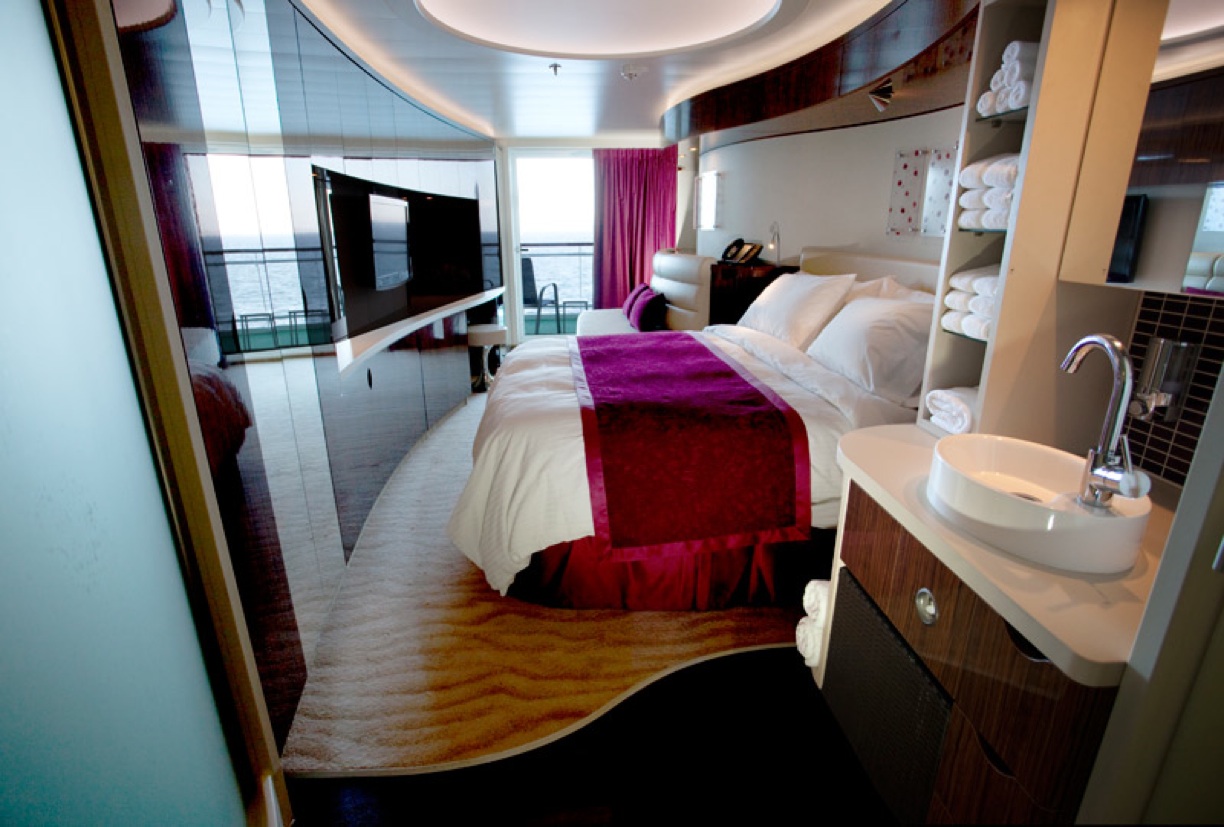 and the all-glass sliding balcony doors
offered a stunning view from any point in the room.
Yet as nice as the room was, I quickly tossed my suitcase
on the
floor and set out to experience the ship’s endless entertainment and
dining
options. I made my way up to the pool
deck, which consisted of three
giant water slides, a rock climbing wall, an arcade, an outside dining
space
with a huge bar, multiple swimming pools and Jacuzzis, and an elevated
lounge
section that wrapped around the entire perimeter of the
deck. I was immediately greeted by
a friendly staff member who asked me if I needed a water or beverage
from the
bar. Overall, the service staff
was excellent, attentive, always smiling, and made me feel welcome and
appreciated, a quality not always found on many large and
impersonal cruise lines.
and the all-glass sliding balcony doors
offered a stunning view from any point in the room.
Yet as nice as the room was, I quickly tossed my suitcase
on the
floor and set out to experience the ship’s endless entertainment and
dining
options. I made my way up to the pool
deck, which consisted of three
giant water slides, a rock climbing wall, an arcade, an outside dining
space
with a huge bar, multiple swimming pools and Jacuzzis, and an elevated
lounge
section that wrapped around the entire perimeter of the
deck. I was immediately greeted by
a friendly staff member who asked me if I needed a water or beverage
from the
bar. Overall, the service staff
was excellent, attentive, always smiling, and made me feel welcome and
appreciated, a quality not always found on many large and
impersonal cruise lines.
Mid-afternoon, I grabbed a
quick
bite from the Noodle Bar (below), one
of my favorite restaurants onboard, and started
with some crispy fried pork pot stickers accompanied by a ginger-soy
sauce, and
finished with a tasty Peking style lo mein
mixed 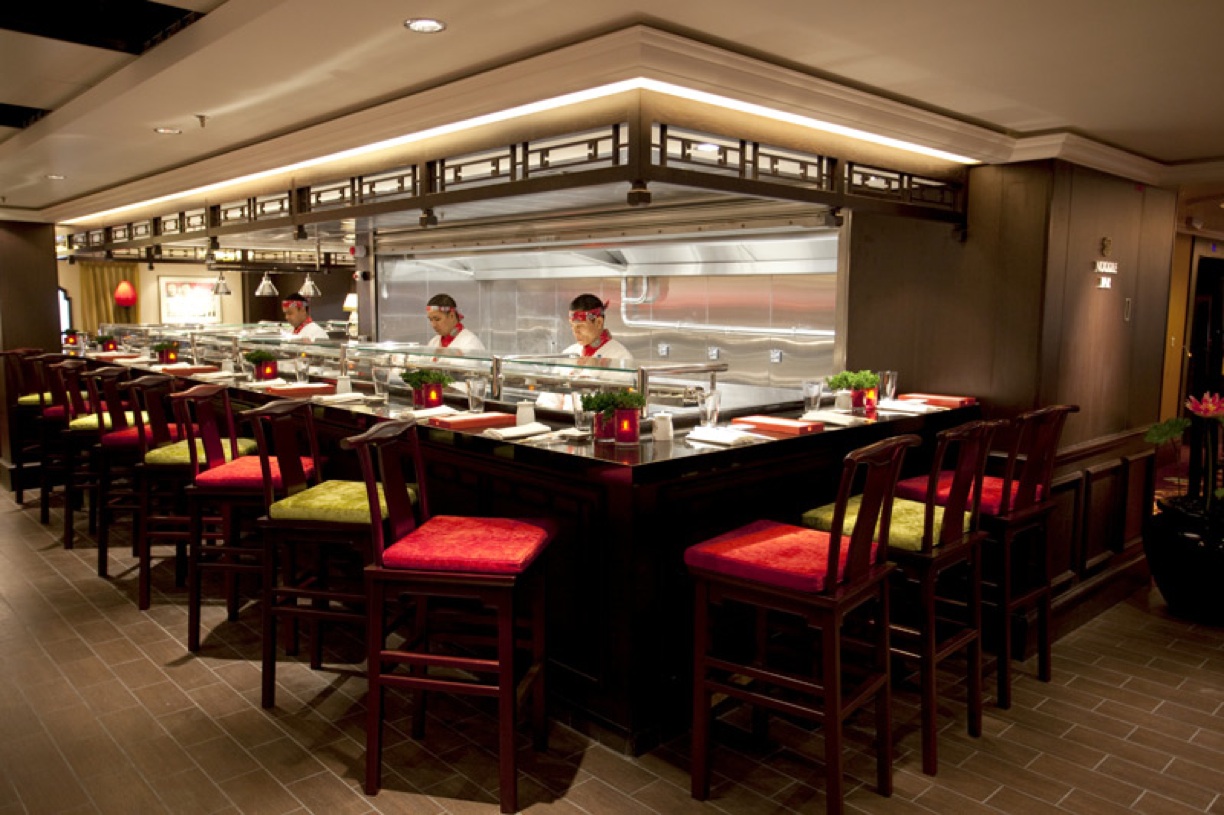 with sautéed shrimp and
chicken. That evening, I dined at Teppanyaki (below), a
hibachi-style Japanese restaurant with some newly acquired
friends as we all engaged with our entertaining chef who flipped rice
bowls
into the air and caught them in his chef’s hat, and also set off
small
fires erupting from onion volcano on the flatiron grill.
The ingredients were fresh, flavorful
(ah! the wonders of cooking with garlic butter!), and the
amount
steak and seafood well worth the $25 charge.
with sautéed shrimp and
chicken. That evening, I dined at Teppanyaki (below), a
hibachi-style Japanese restaurant with some newly acquired
friends as we all engaged with our entertaining chef who flipped rice
bowls
into the air and caught them in his chef’s hat, and also set off
small
fires erupting from onion volcano on the flatiron grill.
The ingredients were fresh, flavorful
(ah! the wonders of cooking with garlic butter!), and the
amount
steak and seafood well worth the $25 charge.
After
dinner I walked through the Epic’s large casino, past its three-lane
bowling
alley, and made my way into the enormous Epic Theater where I watched a
great
performance by the famous Blue Man
Group. When the show was over, I
headed to the blackjack tables
and played a
few hands. The casino takes up
most of Deck Six and has a wide range of table games surrounded by slot
machines that were surprisingly empty. After
realizing
luck
had
not
decided
to
grace
me
that evening, I
said goodbye to my dealer and headed over to Bliss Ultra Lounge the ship’s
lounge/nightclub
packed with guests
dancing while the cocktails continued to flow
through the night. Around three a.m. I
made the right decision and called it a night, heading back to my
cabin,
where I
slept like a baby.
The
following morning I was in need of a good hearty breakfast, so I went
to the Garden Café, 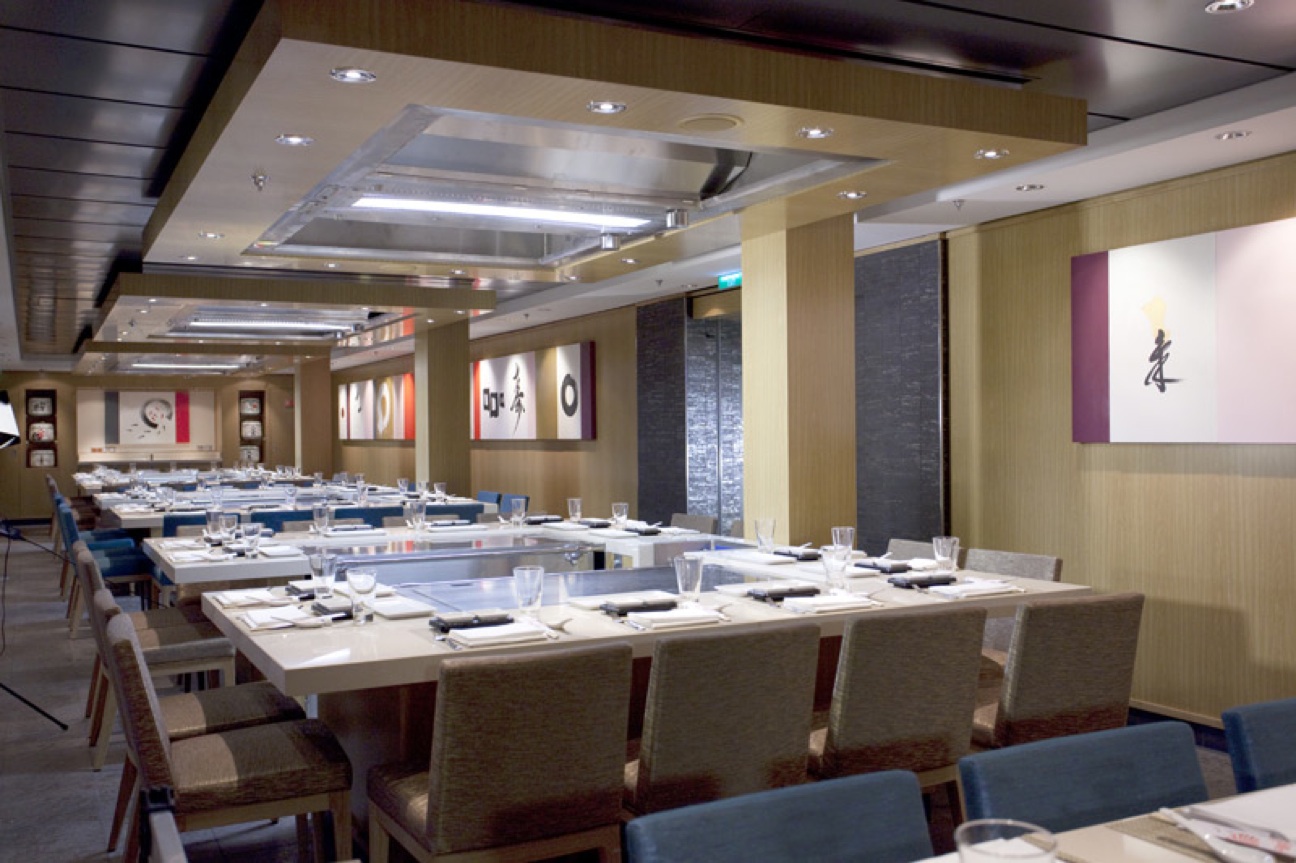 located on the pool deck, and ate from a
fabulous buffet that
served every breakfast item known to man, including eggs, sausage,
bacon,
cereals, pastries, and on and on. Once
re-fueled,
I
grabbed
a
towel
and
sat
poolside
for
a few hours, staring off into
the ocean
and enjoying some well needed relaxation after the late night hours. That afternoon I yearned for a light lunch, so
went to Wasabi, where I
sat at the sushi bar and tried out some
negiri and house specialty rolls. The
fish
was
very
fresh,
the
presentation
was
lovely,
but
the amount of fish inside the rolls and on
the negiri was a far cry
from generous.
located on the pool deck, and ate from a
fabulous buffet that
served every breakfast item known to man, including eggs, sausage,
bacon,
cereals, pastries, and on and on. Once
re-fueled,
I
grabbed
a
towel
and
sat
poolside
for
a few hours, staring off into
the ocean
and enjoying some well needed relaxation after the late night hours. That afternoon I yearned for a light lunch, so
went to Wasabi, where I
sat at the sushi bar and tried out some
negiri and house specialty rolls. The
fish
was
very
fresh,
the
presentation
was
lovely,
but
the amount of fish inside the rolls and on
the negiri was a far cry
from generous.
That evening I dined at the Spiegel Tent (below) and was entertained by "Cirque Dreams & Dinner." The restaurant is designed to reflect the inside of a circus tent and all tables focus around a small stage where the Cirque show takes place. The meal of shrimp salad and beef with vegetables was mediocre and predictable-- I’m pretty sure the focus of the Spiegel Tent is not intended to be the food--but the performers were superb, executing flawless acrobats and balancing acts that had me on the edge of my seat for more than 90 minutes.
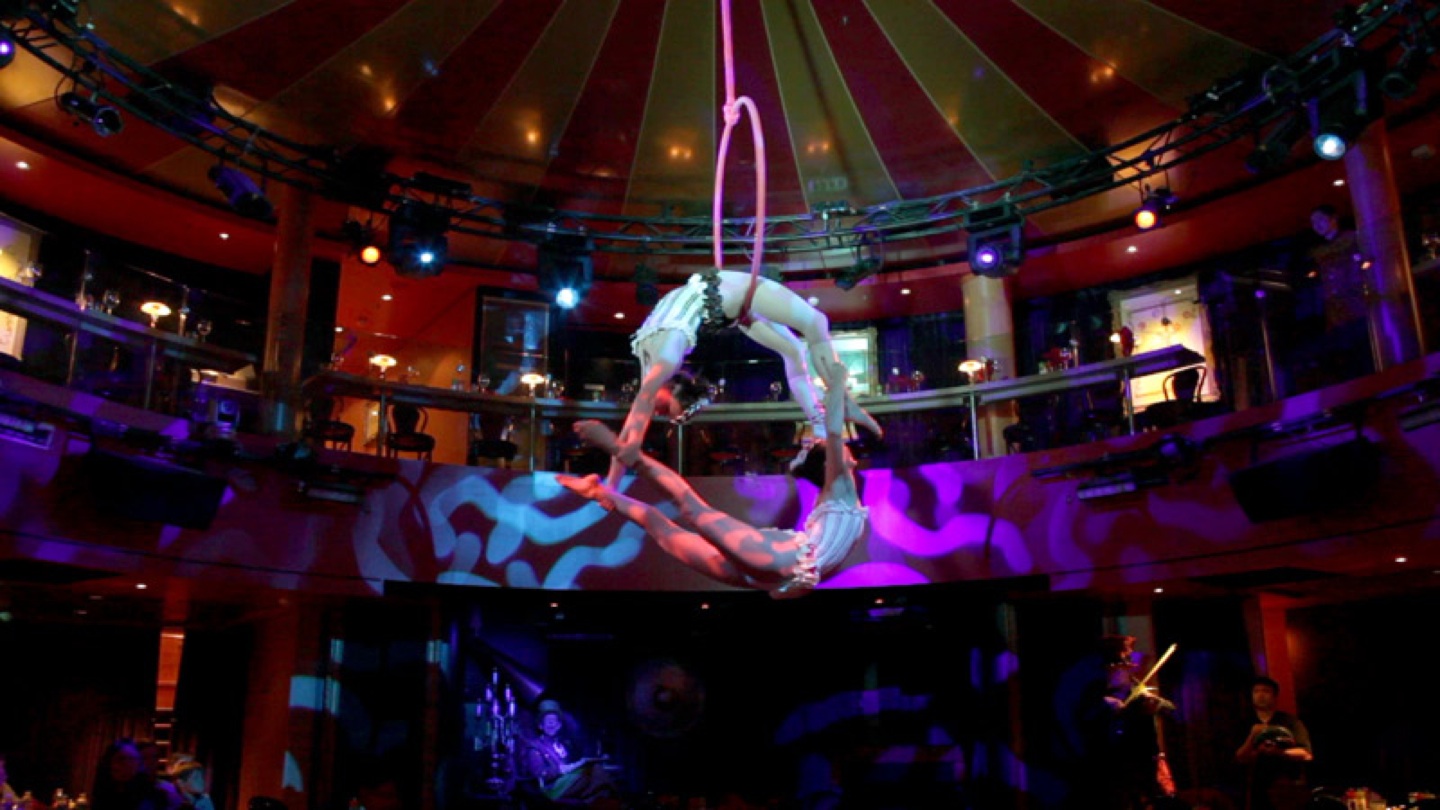 After
dinner I made my way to O’Sheehan’s
Neighborhood Bar for an after dinner drink
and a few games of air hockey and pool. O’Sheehan’s
is
probably
one
of
the
largest
bars
onboard
and attracts a
good crowd of people. O’Sheehan’s
also offers a late night bar menu for those craving buffalo wings,
burgers, and
mozzarella sticks, all very well prepared. To
end
the
night,
I
stopped
by Shaker’s
Martini Lounge where
I enjoyed the music of a Michael Bublé double, who specialized
in Sinatra hits.
After
dinner I made my way to O’Sheehan’s
Neighborhood Bar for an after dinner drink
and a few games of air hockey and pool. O’Sheehan’s
is
probably
one
of
the
largest
bars
onboard
and attracts a
good crowd of people. O’Sheehan’s
also offers a late night bar menu for those craving buffalo wings,
burgers, and
mozzarella sticks, all very well prepared. To
end
the
night,
I
stopped
by Shaker’s
Martini Lounge where
I enjoyed the music of a Michael Bublé double, who specialized
in Sinatra hits.
After two days we pulled
back into port, definitely not
enough time to
experience everything the ship had to offer, but it did provide a
snapshot of
the ship’s emphasis on quality dining and entertainment.
Large cruise ships are generally known
for sub-par buffets and unoriginal restaurants, but the Epic certainly does not
fall into this category. The ship
hosts 21 different restaurants for its guests, accommodating all
palates and
appetites, a number no other line approaches. So, is bigger
better then? Well, it certainly offers more options than any ships at
sea right now.
Norwegian Epic will sail out of
Miami, making 7-day alternating Eastern + Western Caribbean sailings
through April 2011. It will then sail the Med out of Barcelona next
summer, through Oct 2011. The ship will visit Nassau, Bahamas; St
Thomas; and St. Maarten on the Eastern Caribbean itinerary and Cozumel,
Roatan, Honduras and Costa Maya, Mexico on the Western Caribbean
itinerary. Rooms start at $799 per person.
~~~~~~~~~~~~~~~~~~~~~~~~~~~~~
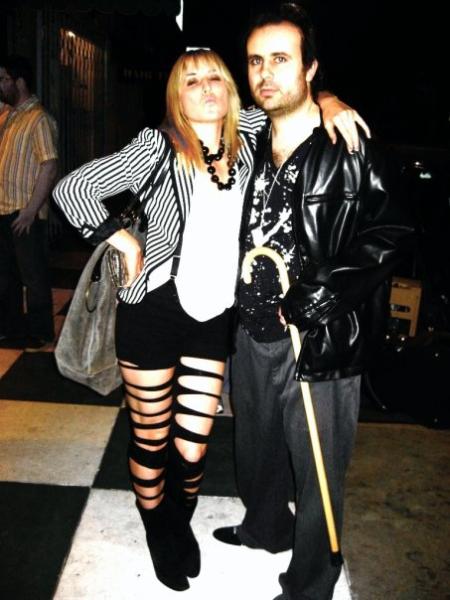 GOOFIEST
METAPHOR
OF
2010
(SO
FAR)
GOOFIEST
METAPHOR
OF
2010
(SO
FAR)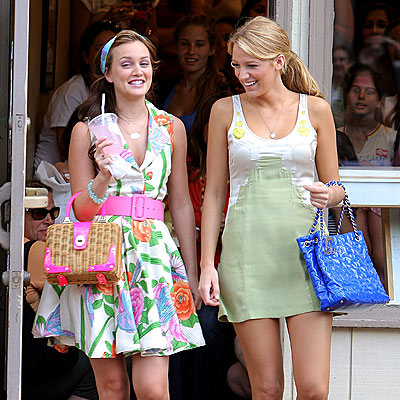
"The result is a restaurant with a bit of an awkwardness to it, as if it were a teenage girl trying to decide whether to spend the summer in the pastel plaids of a breezy Hamptons all-American sun-kissed blonde or in the meticulously tattered leggings of a cutely disaffected downtown art student."--Teresa Politano, "Bar Cara," Newark Star-Ledger (June 18).
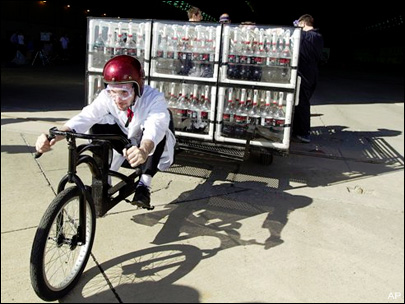
BP
HAS
ALREADY
BOUGHT
THE
PATENT IN ORDER TO KILL IT
In Buckhead, Maine, Fritz Grobe and Stephen Voltz have found a way of powering a bike and a trailer by using hundreds of pieces of Mentos candy and Coke Zero.
A video shows the machine traveled more than 220 feet.
QUICK BYTES
Guidelines for submissions: QUICK BYTES publishes only events, special dinners, etc, open to the public, not restaurant openings or personnel changes. When submitting please send the most pertinent info, incl. tel # and site, in one short paragraph as simple e-mail text, WITH DATE LISTED FIRST, as below. Thanks. John Mariani
* On Aug. 10
and Aug. 24 in San Francisco, CA, Urban Tavern hosts a Monterey Wine
Company wine tasting with hors d’ouevres, 6–7 pm, $10 pp. Call
415-923-4400, www.urbantavernsf.com.
* On Aug. 14 and 15 in Snowmass, CO, the First Annual Culinary & Art Festival, features Chefs Laurent Tourondel and Alfred Portale, PBS Chef Christy Rost, Denver’s Chef Frank Bonanno, et al. Food, wine and spirits, with juried exhibit of local and national artists’ works. $65 pp.; www.snowmassculinaryandarts.com . Call 970-925-1663
*
On Aug. 19 in Avon, CO, Wolfgang
Puck and Napa Valley winery owner Randy Lewis will host a 5-course
dinner,
paired with varietals from award-winning Lewis Cellars, at Spago
in
The
Ritz-Carlton,
Bachelor
Gulch to benefit First
Descents. $225 pp. Call 970-343-1555.
*On
August 24 in Los Angeles, Craft will host their next monthly
winemaker
dinner with Tyler Winery, winespaired with a four-course dinner from
chef Anthony Zappola.
$140pp. Call 424-204-7485 or email amorini@craftlosangeles.com.
* On Aug. 28
– 29 in Aspen, CO, the 1st Annual Big Aspen Barbecue Block
Party presents pitmasters, live
music, BBQ seminars, and grilling demos for guests. Free admission; $8
per BBQ
plate. Visit www.bigaspenbbq.org
or call 970-920-4600.
*
From
Sept.
2-6,
the
22nd annual Pinehurst Food
and Wine Festival will feature some of the best in international
wine and
culinary talent, including Food Network's Florian Bellanger, incl.
seminars, culinary demos and evening galas. Rates
start at $292 pp per night for all events. Visit http://www.pinehurstwinefest.com
* From Sept. 3-5 in Yountville, CA, Chef Thomas Keller will host a Labor Day Weekend fundraising event to support The Bocuse d’Or USA Foundation, with a lineup of meals at Chef Keller’s The French Laundry, Bouchon and Ad Hoc as well as the chance to interact with Chef Keller himself informally. $2,750 pp or $5,250 pc. Visit www.bocusedorusa.org/events
~~~~~~~~~~~~~~~~~~~~~~~~~~~
Everett Potter's Travel Report:

~~~~~~~~~~~~~~~~~~~~~~~~~~~~~~~~~~~~~~~~~~~~~~~~~~~~~~~~~~~~~~~~~~~~~~~~~~
Eating Las Vegas is the new on-line site for Virtual Gourmet contributor John A. Curtas., who since 1995 has been commenting on the Las Vegas food scene and reviewing restaurants for Nevada Public Radio. He is also the restaurant critic for KLAS TV, Channel 8 in Las Vegas, and his past reviews can be accessed at KNPR.org. Click on the logo below to go directly to his site.
~~~~~~~~~~~~~~~~~~~~~~~~~~~~~~~~~~~~~~~~~~~~~~~~~~~~~~~~~~~~~~~~~~~~~~~~~~~
Tennis Resorts Online: A Critical Guide to the World's Best Tennis Resorts and Tennis Camps, published by ROGER COX, who has spent more than two decades writing about tennis travel, including a 17-year stretch for Tennis magazine. He has also written for Arthur Frommer's Budget Travel, New York Magazine, Travel & Leisure, Esquire, Money, USTA Magazine, Men's Journal, and The Robb Report. He has authored two books-The World's Best Tennis Vacations (Stephen Greene Press/Viking Penguin, 1990) and The Best Places to Stay in the Rockies (Houghton Mifflin, 1992 & 1994), and the Melbourne (Australia) chapter to the Wall Street Journal Business Guide to Cities of the Pacific Rim (Fodor's Travel Guides, 1991). THIS WEEK:

Family Travel
Forum: The
Family
Travel
Forum
(FTF),
whose
motto
is
"Have
Kids,
Still
Travel!",
is
dedicated
to
the
ideals,
promotion
and
support
of
travel
with
children.
Founded
by
business
professionals
John Manton and Kyle
McCarthy with first class travel industry credentials and global family
travel experience, the independent, family-supported FTF will provide
its members with honest, unbiased information, informed advice and
practical tips; all designed to make traveling a rewarding, healthy,
safe, better value and hassle-free experience for adults and children
who journey together. Membership in FTF will lead you to new worlds of
adventure, fun and learning. Join the movement.
All You Need to Know Before You Go
nickonwine: An engaging, interactive wine column by Nick Passmore, Artisanal Editor, Four Seasons Magazine; Wine Columnist, BusinessWeek.com; nick@nickonwine.com; www.nickonwine.com.

MARIANI'S VIRTUAL GOURMET NEWSLETTER is published weekly. Editor/Publisher: John Mariani.
Contributing Writers: Christopher
Mariani, Robert Mariani,
John A. Curtas, Edward Brivio, Mort
Hochstein, Suzanne Wright, and Brian Freedman. Contributing
Photographers: Galina Stepanoff-Dargery, Bobby Pirillo. Technical
Advisor:
Gerry McLoughlin.
Any of John Mariani's books below
may be ordered from amazon.com by clicking on the cover image.
 My
newest book, written with my brother Robert Mariani, is a memoir of our
years growing up in the My
newest book, written with my brother Robert Mariani, is a memoir of our
years growing up in the For those of you who don't think of the Robert and I think you'll enjoy this very personal look at our --John Mariani |
 |
 |
 |
 |
 |
 |
© copyright John Mariani 2010
